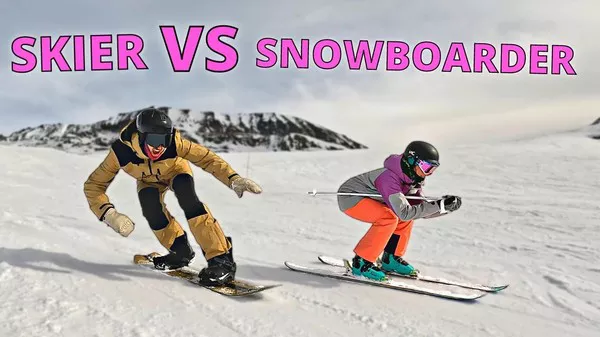Skiing and snowboarding are two exhilarating winter sports that attract millions of enthusiasts worldwide. Both offer unique experiences on the slopes, but the question of which is safer often arises among beginners and seasoned participants alike. In this comprehensive analysis, we delve into injury statistics, factors influencing safety, unique risks for each sport, safety tips, and an objective comparison to determine the relative safety of skiing versus snowboarding.
Injury Statistics
Understanding injury statistics is crucial in assessing the safety of skiing and snowboarding. According to reputable sources such as the National Ski Areas Association (NSAA) and the National Ski Patrol (NSP), both sports carry inherent risks, but the nature and frequency of injuries differ.
1. Types of Injuries: Skiing is associated with a higher incidence of knee ligament tears, particularly the anterior cruciate ligament (ACL), and hand injuries known as “skier’s thumb,” resulting from falls or collisions. Snowboarding, on the other hand, sees a higher prevalence of wrist fractures and concussions due to the nature of falls and impacts.
2. Skill Level Disparities: Injury rates vary significantly depending on skill level. Beginners are more prone to accidents as they are less adept at controlling their movements and may lack proper technique. Intermediate and advanced skiers and snowboarders tend to have lower injury rates due to improved skill and experience, though they may engage in riskier behaviors on more challenging terrain.
Factors Influencing Safety
Several factors influence the safety of skiing and snowboarding, including terrain, equipment, skill level, and awareness/responsibility.
1. Terrain: The choice of terrain plays a crucial role in safety. Beginner slopes with gentle gradients and fewer obstacles are safer for novice skiers and snowboarders, allowing them to practice basic techniques and build confidence. Advanced runs with steeper inclines and more obstacles pose greater challenges and risks, requiring advanced skills and experience to navigate safely.
2. Equipment: Proper equipment is essential in mitigating injury risks. Helmets are recommended for both skiing and snowboarding to protect against head injuries, while wrist guards can reduce the incidence of wrist fractures in snowboarders. Additionally, well-maintained and correctly fitted ski bindings can help prevent knee injuries by releasing the boots during falls.
3. Skill Level and Instruction: Beginners should prioritize lessons and instruction to learn fundamental techniques and safety protocols from qualified instructors. Learning proper stance, turning, and stopping techniques significantly reduces the likelihood of accidents and injuries. Even experienced skiers and snowboarders can benefit from occasional lessons to refine their skills and learn advanced maneuvers safely.
4. Awareness and Responsibility: Practicing awareness and responsibility on the slopes is paramount for safety. This includes adhering to the skier’s responsibility code, which emphasizes yielding to others, staying in control, and avoiding reckless behavior. Being mindful of one’s surroundings, weather conditions, and personal limits can help prevent accidents and injuries.
Unique Risks for Each Sport
While skiing and snowboarding share common risks, each sport also presents unique injury patterns and vulnerabilities.
1. Skiing: Common skiing injuries include ACL tears, which often occur during twisting falls or abrupt changes in direction. Skier’s thumb, a sprain or tear of the thumb ligament, can result from falling with the ski pole still in hand or catching the thumb on the ski pole strap during a fall.
2. Snowboarding: Snowboarders are more susceptible to wrist fractures due to the instinctive reaction to break a fall with outstretched hands. Additionally, the risk of concussions is higher in snowboarding, particularly during falls that result in impacts to the head or neck.
Safety Tips for Both Sports
To minimize the risk of injury while skiing or snowboarding, consider the following safety tips:
- Warm-up: Perform dynamic stretches and warm-up exercises before hitting the slopes to prepare your muscles and reduce the risk of strains or pulls.
- Stay Hydrated: Dehydration can impair performance and judgment, increasing the risk of accidents. Drink plenty of water throughout the day, especially at high altitudes.
- Take Breaks: Fatigue can compromise coordination and reaction times, making accidents more likely. Take regular breaks to rest and recharge, particularly during extended sessions on the slopes.
- Use Safety Equipment: Wear appropriate safety gear, including helmets, goggles, wrist guards (for snowboarding), and properly fitted ski boots with adjusted bindings.
- Take Lessons: Invest in lessons from certified instructors to learn proper techniques and safety protocols. Beginners should start with basic lessons to develop essential skills and confidence.
Objective ComparisonIt’s essential to approach the comparison of skiing and snowboarding safety objectively, considering the interplay of various factors.
While skiing may have a higher incidence of certain types of injuries, such as ACL tears, snowboarding carries a greater risk of wrist fractures and concussions. Injury rates also vary depending on skill level, terrain, and adherence to safety guidelines.
Ultimately, the safety of skiing versus snowboarding is subjective and multifaceted. Both sports offer unique experiences and challenges, and the decision of which to pursue should be based on personal preferences, skill level, and commitment to safety.
Conclusion
In conclusion, skiing and snowboarding can be enjoyed safely with proper preparation, instruction, and awareness. By understanding the risks and taking appropriate precautions, enthusiasts can minimize the likelihood of accidents and injuries, ensuring a rewarding and exhilarating experience on the slopes.

